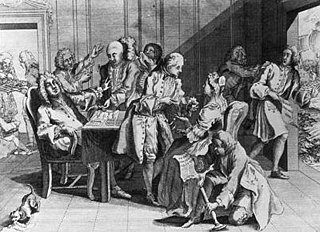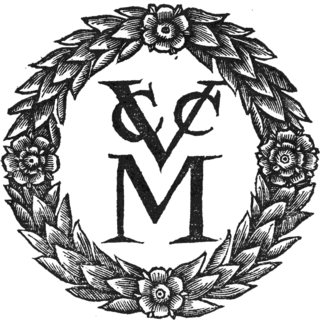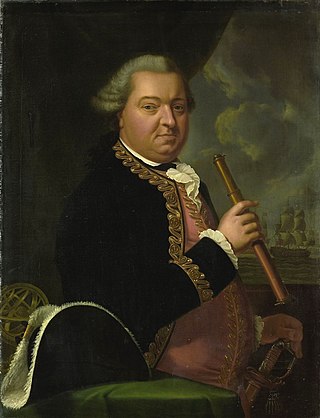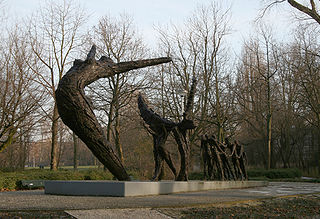
The Dutch West India Company was a Dutch chartered company that was founded in 1621 and went defunct in 1792. Among its founders were Reynier Pauw, Willem Usselincx (1567–1647), and Jessé de Forest (1576–1624). On 3 June 1621, it was granted a charter for a trade monopoly in the Dutch West Indies by the Republic of the Seven United Netherlands and given jurisdiction over Dutch participation in the Atlantic slave trade, Brazil, the Caribbean, and North America.

1738 (MDCCXXXVIII) was a common year starting on Wednesday of the Gregorian calendar and a common year starting on Sunday of the Julian calendar, the 1738th year of the Common Era (CE) and Anno Domini (AD) designations, the 738th year of the 2nd millennium, the 38th year of the 18th century, and the 9th year of the 1730s decade. As of the start of 1738, the Gregorian calendar was 11 days ahead of the Julian calendar, which remained in localized use until 1923.

The Middle Passage was the stage of the Atlantic slave trade in which millions of enslaved Africans were forcibly transported to the Americas as part of the triangular slave trade. Ships departed Europe for African markets with manufactured goods, which were then traded for slaves with rulers of African states and other African slave traders. Slave ships transported the slaves across the Atlantic. The proceeds from selling slaves were then used to buy products such as furs and hides, tobacco, sugar, rum, and raw materials, which would be transported back to Europe to complete the triangle.

The Asiento de Negros was a monopoly contract between the Spanish Crown and various merchants for the right to provide enslaved Africans to colonies in the Spanish Americas. The Spanish Empire rarely engaged in the transatlantic slave trade directly from Africa itself, choosing instead to contract out the importation to foreign merchants from nations more prominent in that part of the world, typically Portuguese and Genoese, but later the Dutch, French, and British. The Asiento did not concern French or British Caribbean but Spanish America.

Slave ships were large cargo ships specially built or converted from the 17th to the 19th century for transporting slaves. Such ships were also known as "Guineamen" because the trade involved human trafficking to and from the Guinea coast in West Africa.

The Dutch Gold Coast or Dutch Guinea, officially Dutch possessions on the Coast of Guinea was a portion of contemporary Ghana that was gradually colonized by the Dutch, beginning in 1612. The Dutch began trading in the area around 1598, joining the Portuguese which had a trading post there since the late 1400s. Eventually, the Dutch Gold Coast became the most important Dutch colony in West Africa after Fort Elmina was captured from the Portuguese in 1637, but fell into disarray after the abolition of the slave trade in the early 19th century. On 6 April 1872, the Dutch Gold Coast was, in accordance with the Anglo-Dutch Treaties of 1870–71, ceded to the United Kingdom.

The first wave of European colonization began with Spanish and Portuguese conquests and explorations, and primarily involved the European colonization of the Americas, though it also included the establishment of European colonies in India and in Maritime Southeast Asia. During this period, European interests in Africa primarily focused on the establishment of trading posts there, particularly for the African slave trade. The wave ended with the British annexation of the Kingdom of Kandy in 1815 and the founding of the colony of Singapore in 1819.

Sunny South, an extreme clipper, was the only full-sized sailing ship built by George Steers, and resembled his famous sailing yacht America, with long sharp entrance lines and a slightly concave bow. Initially, she sailed in the California and Brazil trades. Sold in 1859 and renamed Emanuela, she was considered to be the fastest slaver sailing out of Havana. The British Royal Navy captured Emanuela off the coast of Africa in 1860 with over 800 slaves aboard. The Royal Navy purchased her as a prize and converted her into a Royal Navy store ship, Enchantress. She was wrecked in the Mozambique Channel in 1861.

African Slave Trade Patrol was part of the Blockade of Africa suppressing the Atlantic slave trade between 1819 and the beginning of the American Civil War in 1861. Due to the abolitionist movement in the United States, a squadron of U.S. Navy warships and cutters were assigned to catch slave traders in and around Africa. In 42 years about 100 suspected slave ships were captured.

The Middelburgsche Commercie Compagnie (MCC) was a Dutch trading company established in 1720 in the Zeeland capital of Middelburg, Netherlands. It was initially called the Commercial Company of the city of Middelburg. However, after the archive industry was published in 1950 by W.S. Unger, it became known as the Middelburg Commercial Company. After the monopoly of the Dutch West India Company for the Atlantic slave trade was abolished in 1730, the MCC became the principal Dutch slave trading company around 1746. In 1777 the company shipped gunpowder and arms to Sint Eustatius and the island was blockaded by the British Navy. The company was eventually liquidated in 1889.

Surinam, also unofficially known as Dutch Guiana, was a Dutch plantation colony in the Guianas and the predecessor polity of modern country of Suriname. It was bordered by the fellow Dutch colony of Berbice to the west, and the French colony of Cayenne to the east. It later bordered British Guiana from 1831 to 1966.
The Anglo-Dutch Slave Trade Treaty was a treaty signed between the United Kingdom and the Kingdom of the Netherlands signed on 4 May 1818, aimed at preventing slave trade carried out through Dutch vessels. The treaty allowed both parties to search vessels of the other for on-board slaves. Among other things, the treaty established two Mixed Commission Courts, one with a seat in Freetown, Sierra Leone and another in Paramaribo, Suriname, which had the power to sentence slavers.
John and James was built in France in 1791 under another name and taken in prize in 1796. New owners renamed her and initially sailed her as a West Indiaman. She then made a voyage for the British East India Company (EIC). Next, she became a slave ship, making three voyages between West Africa and the West Indies. Finally, she became a whaler, but was lost in 1806 to a mutinous crew.
Wilding was launched at Liverpool in 1788 and spent much of her career as a West Indiaman, sailing between Liverpool and Jamaica. During this time, in November 1794, she participated in a single-ship action during which her opponent, a French privateer, blew up. In 1798 after a series of captures and recaptures she briefly became a transport for the French Navy, but a final recapture returned her to British hands. Later, she made one voyage to the South Pacific as a whaler, and one voyage to the Cape of Good Hope as a victualler for the 1795-1796 invasion of the Cape. She traded with the West Indies, Africa, the United States, and Russia. Her crew abandoned her in September 1824, dismasted and in a sinking state.
Proserpine was launched at Amsterdam in 1801 as a 32-gun frigate. The Royal Navy captured her in May 1804 at the capture of Surinam and took her into service as HMS Amsterdam. She sailed to England where she became a guard and storeship at Cork. She was sold in 1815.

Willem Krul was a Dutch States Navy officer best known for his actions during the American Revolutionary War. He was also known as Adrianus Hendrik Willem Krul. After serving in various assignments about the European Atlantic coast Krul served in his final naval assignment at Saint Eustatius, a Dutch possession in the West Indies, during which time he lost his life while engaged in a naval battle with the British, making him a national hero in the Netherlands.

The history of slavery in the Netherlands dates back to the period of classical antiquity. During the early modern period, Dutch slave traders bought and sold over 1.6 million enslaved people. The Netherlands abolished Dutch involvement the Atlantic slave trade in 1814 under diplomatic pressure from the United Kingdom, but slavery would continue to exist in the Dutch colonial empire until 1863.
Mary Ann was launched in 1807 at Liverpool. She made one voyage as a slave ship in the triangular trade in enslaved people. She then became a West Indiaman. From 1811 she became a Falmouth packet. In 1813 a United States privateer captured her.
Doe was built in 1780, in the Thirteen Colonies, possibly under another name. She was taken in prize. Between 1783 and 1786 Doe made three complete voyages as a slave ship in the triangular trade in enslaved people. New owners in 1787 renamed Doe to Ellen. Ellen was registered in Liverpool in 1787. Between 1789 and 1792, she made two complete voyages transporting enslaved people. A French privateer captured her in 1793 as she was on her way to the West Indies having embarked captives in Africa on her sixth voyage transporting enslaved people.











